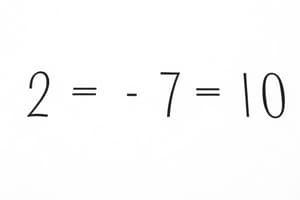Podcast
Questions and Answers
What is the result of $2 \times 9 \div 4$?
What is the result of $2 \times 9 \div 4$?
- $9/2$ (correct)
- $7/4$
- $1.5$
- $3$
The fraction $3/8$ represents a quarter of a whole.
The fraction $3/8$ represents a quarter of a whole.
False (B)
What fraction represents the number of children if $3/8$ are men and $5/12$ are women in a housing estate with 720 residents?
What fraction represents the number of children if $3/8$ are men and $5/12$ are women in a housing estate with 720 residents?
Children represent $24/24 - 9/24 - 10/24 = 5/24$.
The number of residents if $5/6$ of them is $120$ can be expressed as _____.
The number of residents if $5/6$ of them is $120$ can be expressed as _____.
Match the fractions with their equivalent values:
Match the fractions with their equivalent values:
What is $3 \times 16 / 27$ simplified?
What is $3 \times 16 / 27$ simplified?
The fraction $1/5$ is equivalent to $0.2$.
The fraction $1/5$ is equivalent to $0.2$.
If $2 \times 5 \times 2 / 9$ is calculated, what is the result?
If $2 \times 5 \times 2 / 9$ is calculated, what is the result?
The number which $5/6$ equals $120$ is _____.
The number which $5/6$ equals $120$ is _____.
How many children are in the housing estate if the total number of residents is 720 and fractions of men and women are given?
How many children are in the housing estate if the total number of residents is 720 and fractions of men and women are given?
Flashcards are hidden until you start studying
Study Notes
Absolute Value and Integer Comparison
- Absolute value of an integer omits the sign.
- In positive integers, the one with a greater absolute value is larger.
- In negative integers, the one with a smaller absolute value is larger.
- Every positive integer is greater than all negative integers.
- Positive integers are located to the right of zero on the number line, while negative integers are to the left.
Operations with Integers
- Addition of two positive integers yields another positive integer.
- Addition of two negative integers results in a negative integer.
- Adding a positive and a negative integer results in:
- Positive if the positive integer has a greater absolute value.
- Negative if the negative integer has a greater absolute value.
- The sum's absolute value equals the difference of their absolute values.
Subtraction of Integers
- Subtracting an integer is equivalent to adding its opposite: ( a - b = a + (-b) ).
Multiplication of Integers
- Multiplying two integers with the same sign results in a positive integer.
- Multiplying integers with opposite signs yields a negative integer.
- Any integer multiplied by zero equals zero.
- Any integer multiplied by one remains unchanged.
Division of Integers
- Dividing integers with the same sign results in a positive quotient.
- Dividing integers with opposite signs results in a negative quotient.
Fractions
- Proper fractions have numerators less than their denominators; improper fractions have numerators equal to or greater than their denominators.
- Mixed fractions can be converted to improper fractions for simplification.
Addition and Subtraction of Fractions
- For like fractions, the sum is the sum of the numerators over a common denominator.
- The same principle applies for subtracting fractions: the difference of the numerators over a common denominator.
Key Examples and Applications
- Children in Housing Estate Problem: Total residents minus the fractions corresponding to men and women reveals the number of children.
Additional Notes
- Utilize clear representations on the number line for fractions.
- Every fraction can be expressed in equivalent forms by multiplying both the numerator and denominator by the same non-zero number.
- The reciprocal of a fraction is found by swapping its numerator and denominator.
Studying That Suits You
Use AI to generate personalized quizzes and flashcards to suit your learning preferences.




